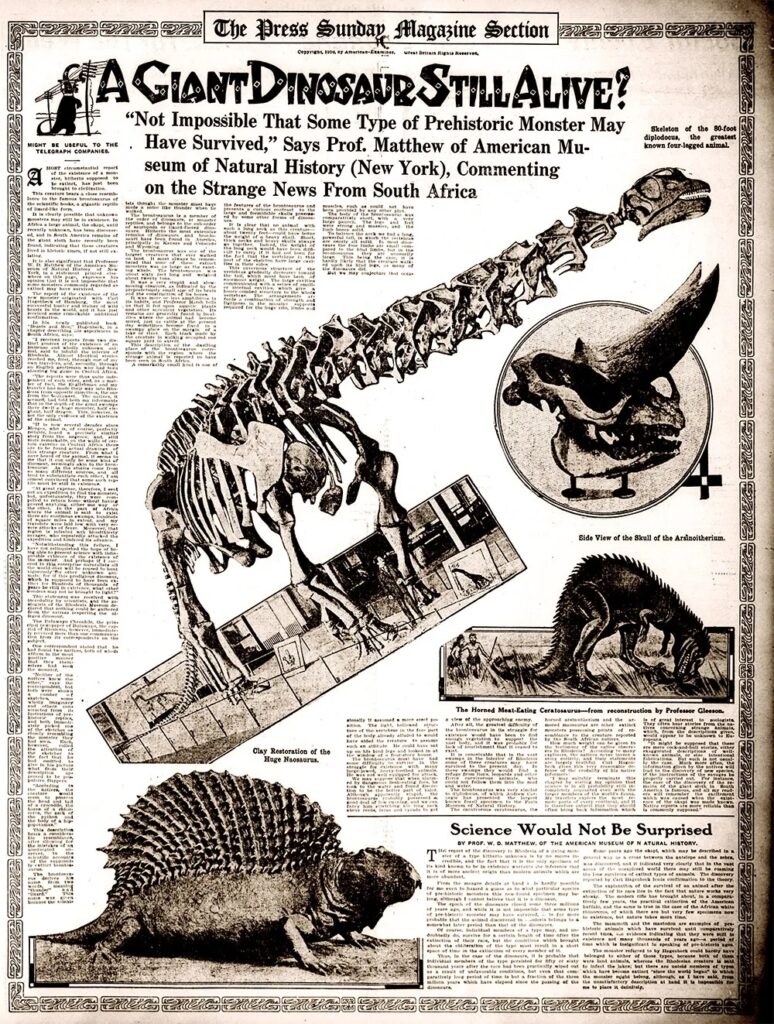
It is sometimes suggested that “alternative facts” are a new, or at least recent phenomenon, but anyone enversed in the history of science can probably easily rattle off a few well-chosen examples from times past. Sometimes, however, the division between what is real and imagined isn’t quite so clear, as the history of the search for living dinosaurs reveals.
Sir Arthur Conan Doyle’s The Lost World (1912) is a strange but highly entertaining amalgam of adventure story and science novel, and probably his best-known work outside of the Sherlock Holmes canon. It has given rise to numerous film adaptations, including one of the first appearances of “living” dinosaurs on celluloid in 1925.
Doyle was likely inspired to write the novel after having spoken at a lunch at the Royal Society in 1910. At that occasion, Robert Peary, who had just returned from his quest to discover the North Pole, was also present. In his talk, Doyle contemplated, in the light of the activities of Peary and others, whether there was any unknown part of the world left for writers of adventure stories to draw their inspiration from. Coupled with Doyle’s admiration for adventurists and his interest in paleontology, The Lost World was his answer to this question..
A Holmesian professor
The Lost World revolves around the attempts of its four protagonists (the narrator, Edward Ned Malone, the scientists Edward Challenger and Arthur Summerlee, and the adventurer / big game hunter Lord John Roxton) to access a near-inaccessible plateau in the Amazon forest, which turns out to be occupied with all sorts of animals that are extinct elsewhere.
Doyle was well aware of the necessity of tying his adventure romp to a central figure of Holmesian dimensions, and Professor Edward Challenger more than fitted the bill. Ostensibly based on one of Doyle’s teachers at Edinburgh University, outwardly Challenger is the sort of detached, larger-than-life figure that had been haunting popular fiction since Mary Shelley’s Frankenstein, or the modern Prometheus. This is no mad scientist of the Faust or Moreau type, however: Challenger is portrayed as a decent and sensitive man, albeit one susceptible to impulsive and irrational action. He is also the target of some of Doyle’s humor, for instance when he is crowned asking by the apes who see a certain likeness in him.
A Big Game
But the more serious focus of the story is on the figure of Lord John Roxton, a big game hunter cum human rights activist allegedly modeled after the diplomat Roger Casement. It is he who compensates for both scientists’ lack of restraint and practicality and for Malone’s youth, and it is also he who demands most of the readers’ admiration.The jocularity which surrounds Challenger, Summerlee, and Malone, is conspicuously absent in Doyle’s treatment of Roxton. For Doyle, he is the embodiment of the lone hero, the risk-taker that shuns no danger to gain knowledge, without losing his moral compass. The role of Roxton is among a number of strangely anti-intellectual currents in the novel, such as Doyle’s obvious disdain for the tendency of scientists to quarrel over apparent minutiae, something reflected both in the various discussions between the two professors, and Challenger’s reception among his peers.
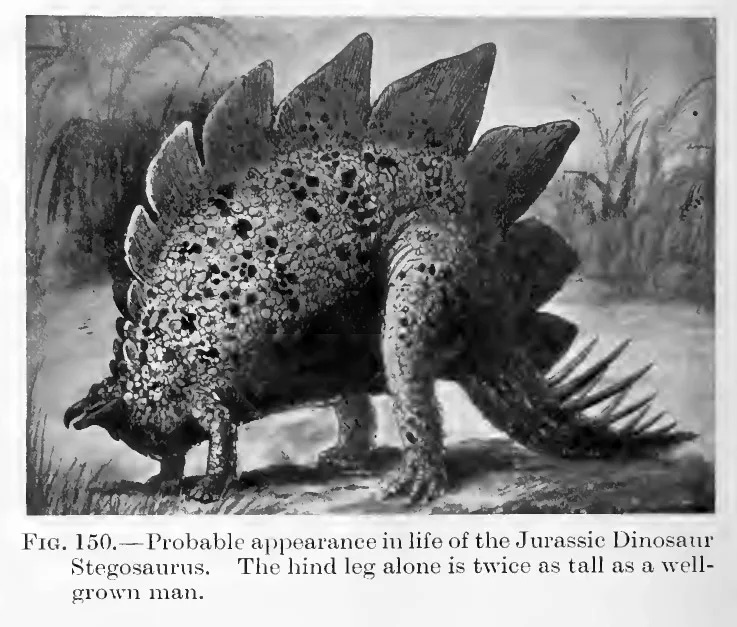
Traceable influences in The Lost World are many: Verne, Wells, Stephenson and Defoe all left their mark on Doyle.But most of his information about prehistoric animals is clearly shaped by E. Ray Lankester’s from1905; some of the illustrations are directly lifted from the book and amended for the purpose. Lankester felt flattered by Doyle’s use of his work, and even suggested a possible sequel to him.. Both men were to meet on a number of occasions after that, not so much to mull over but to discuss the sensational discovery of allegedly (and later discredited) human remains at Piltdown, something for which Doyle himself has sometimes(albeit unconvincingly) been forwarded as the culprit.
Iguanodons
One sign of Lankester’s influence is in the choice of animals that inhabit the plateau on which Challenger and hisparty are marooned: we encounter an unnamed sauropod and carnivorous dinosaur, but also some better-known animals, such as the best-known British dinosaur of all, Iguanodon:
“Iguanodons,” said Summerlee. “You’ll find their footmarks all over the Hastings sands, in Kent, and in Sussex. The South of England was alive with them when there was plenty of good lush green-stuff to keep them going. Conditions have changed, and the beasts died. Here it seems that the conditions have not changed, and the beasts have lived.”
Note the perpetuation of the notion that these animals are unintelligent behemoths at the mercy of their environs, doomed to extinction even here, if the circumstances would change even a little.
Some parts of will sit uneasily with modern audiences. Among the more disturbing events in thebook is the genocide of a race of ape-men by a tribe of indians, with the assistance of the story’s protagonists.Unsurprisingly, this is an aspect usually overlooked in modern film adaptations. Also, the casualness with which Roxton single-handedly decimates wildlife on the plateau is unlikely to endear present-day readers. However, for Doyle this is a way to explain his thoughts (his, certainly not Lankester’s) about extinction and evolution. This episode, and others, infuse the story with a more moralist component that goes back to the early Victorian days of(1840). One example is the description of the pterosaur swamp that the travelers encounter early on at the plateau:
“It was a weird place in itself, but its occupants made it seem like a scene from the Seven Circles of Dante. I.) From this crawling flapping mass of obscene reptilian life came the shocking clamor which filled the air and the mephitic, horrible, musty odor which turned us sick. But above, perched each upon its own stone, tall, gray, and withered, more like dead and dried specimens than actual living creatures, sat the horrible males, absolutely motionless save for the rolling of their red eyes or an occasional snap of their rat-trap beaks as a dragon-fly went past them.”
Doyle, who had thusfar kept his interest in spiritualism out of most of his prose, would go on to use the figure ofChallenger to advance a more openly spiritualist agenda. Stories such as (1913) and even more so (1926) explicitly deal with the afterlife. , on the other hand, is still fairly clean in itsportrayal of science, even if it is placed within Doyle’s largely conventional moral framework..
The Lost World
The whole idea of dinosaurs being alive in some distant part of the now almost-conquered earth was certainly not exclusively Doyle’s. Three years before Doyle started work on, the famous German animal traderCarl Hagenbeck had announced plans to start combing the jungles of southern Africa for dinosaurs. And even he was hardly the first to do so. Starting in the eighteenth century, several travelers had provided (unsubstantiated)reports of encounters with mysterious, often very large creatures in jungles throughout the southern hemisphere.
Fawcett
One of these figures, and another candidate for inclusion in the pot-pourri of inspiration for Professor Edward Challenger’s character traits, was the British explorer Percy Fawcett. He in fact claimed to have given Conan Doyle the idea for the isolated plateau that was the locus for his Lost World.. He stands in a long line of explorers who played out a heated competition with one another, mostly subsidized by the upcoming newspapers presses of theUnited Kingdom and the United States. To many, the explorer was the hero of the modern age, leading a self-effacing and often highly dangerous quest to bring far-away peoples and terrains closer to civilization. And the more inhospitable the terrain, the greater the gains Ñ not only in terms of status for the explorer himself, but also in revenue for their sponsoring newspapers. The element of competition further served to enhance the lure, asDoyle’s table companion Robert Peary should have been able to testify.
Fawcett has mainly become known for his expedition to find the legendary Lost city of Z in the Amazonian jungle in 1925, and his subsequent mysterious disappearance. Fawcett’s earliest exposure to the Amazon took place in 1906, during a Royal Geographic Society expedition to mark the border between Brazil and Peru in which he was involved as a Lieutenant-Colonel in the Royal Engineer Corps.
It was a perilous journey, in which Fawcett had to contend with an unforgiving jungle, indigenous tribes, and the possibility of running into one of the many armed gangs hired by rubber barons to supply them with (involuntary)labor. During that time, Fawcett claimed, he had seen animals of unheard-of dimensions, such as a very large, more than 65-foot Anaconda, and:
“an animal he believed might be Diplodocus, the eighty-foot reptile of twenty-five tons. This animal he though might still be in existence as it was an eater of aquatic plants, which grow profusely in this region. The Diplodocus story is confirmed by many of the tribes east of the Ucayali”.
But overall, Fawcett remained vague. In 1953, a collection of his notes from forty years earlier was worked into astory and published by his son Brian; it was clearly meant to convey a sense of mystery and awe to the reader. Healso reiterated a type of romantic speculation that we see crop up time and again in other authors, includingDoyle:
“Mightn’t there be a few giant monsters, remnants of an extinct species, still living out their lives in the security of the vast unexplored swamp areas? In the Madidi, in Bolivia, enormous tracks have been found, and Indians there talk of a huge creature described at times half submerged in the swamps.”
But the whole phenomenon of the explorer was in essence romantic and, to some degree, anti-scientific. In 1869,James Gordon Bennett jr., proprietor of the New York Herald, had urged Henry Morton Stanley to find DavidLivingstone in the Congo. The narrative that Stanley (and his successors) was to supply to Bennett’s press stayed well away not only from scientific language, but also from the whole idea of scientific progress. Instead, it emphasized the mystery and calamity of the unknown, blank spaces on the map. And it is exactly this sentiment that also pervades Doyle’s . Even with Doyle, romanticism loses out against the new world. There is no room for Doyle’s explorers in a modern society; pitches the four adventurers against the scientific establishment, the romanticism of exploration against cool scientific authority and,quintessentially, the old versus the modern.
The “Keratosaurus“
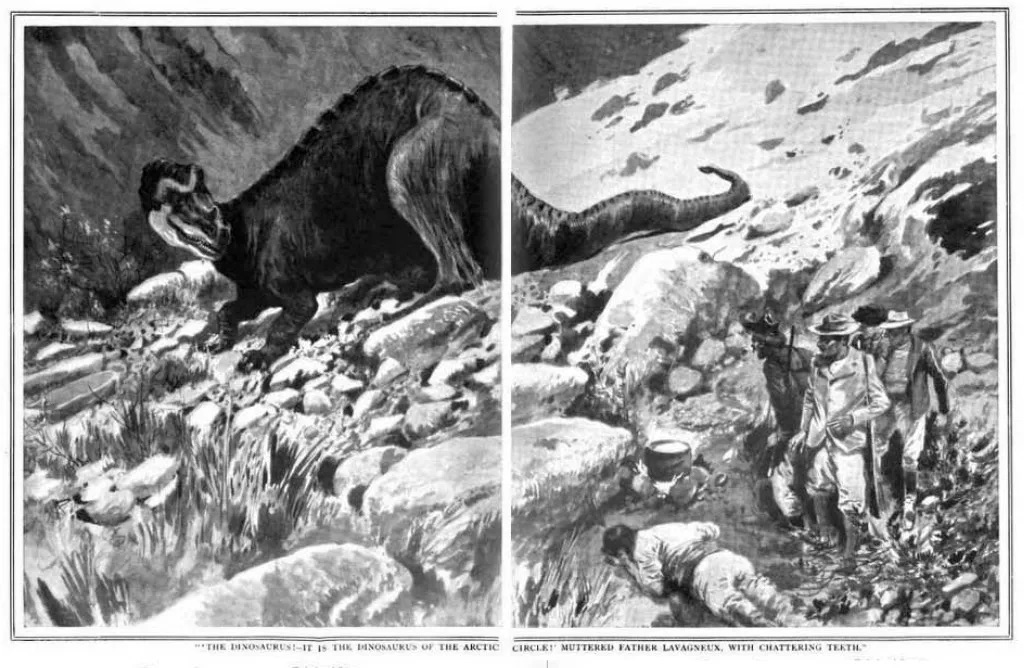
The “rediscovery” of dinosaurs did not remain limited to tropical climes, however. In the spring of 1908, Hugh Grosvenor, 2nd Duke of Westminster and something of an adventure fanatic, set up an expedition to hunt for carnivorous dinosaurs north of the Arctic Circle. In April of that year, the French journalist Georges Dupuy had published a story about his encounter with the “Monster of Partridge Creek”, an Alaskan “Keratosaurus” in the French popular magazine (later serialized in English in ). That drew the attention of both Grosvenor and the press. Ceratosaurus, a genus of carnivorous dinosaurs, had been well-known since the late nineteenth century through a description published by O.C. Marsh. However, the newspapers opened up all registers of purple prose when they imbued an already-respectable dinosaur with a mouth filled with blood-stained slime, red-eyes flamed in the twilight and the ability to carry away moose in its jaws. The expedition planned to bring back the animal alive and exploit it in spectacles. Predictably, a real, living Ceratosaurus never materialized.
African monsters
Even more than South America, it was Africa which came to be considered as a likely source for extinct or other hitherto-undiscovered animals, even large ones. As late as 1901, the world was astounded by the discovery of the Okapi, a relative of the giraffe that had first been spotted in by Stanley in 1883 but remained elusive for twenty years afterwards. Even more promising bounties seemed to be in store. As early as 1776, the Bonaventure Proyart, a French missionary working along the Congo river, reported having seen gigantic footsteps (possibly fossil trackways). Throughout the nineteenth century, indigenous legends of this Mokele-mbembe, as the locals were reported to call it, were brought to Europe. This was said to be a giant animal whose description somewhat resembled the big sauropod dinosaurs that were being uncovered in the American West from the 1870s onwards.
That is to say, it could resemble it provided the right stories from the Congo River basin were picked.Unfortunately, the Congolese stories were far from unanimous in their description of the creature, not evenagreeing on its physical form (or whether it had one). The possible existence of a living sauropod in the African interior turned out to be a magnet to explorers; and to some adventurous souls, the discovery of the remains of dinosaurs at Tendaguru in 1907 only seemed to make such a presence more likely. The fact that around that time the Congo became a byword for the barbarism of dark Africa due to other circumstances, probably helped tocreate an atmosphere in which the occurrence of primeval life in the region appeared likely to contemporary western audiences.
Enter Hagenbeck
However, the tropics remained the most promising place to look for oversized reptilians. It was the German animal dealer and circus owner, Carl Hagenbeck, whose search for living dinosaurs was to make a particularly big impact on the world. In early 1909, he announced his plans to set up an expedition to bring back a dinosaur, a sauropod, from the interior of Africa. His timing was impeccable. A few months earlier, he had contracted the sculptor Josef Pallenberg to design several large sculptures of dinosaurs for his new zoo in Stellingen, nearHamburg. Hagenbeck had been convinced of the survival of prehistoric creatures in the interior of Africa forsome time; he attached particular value to cave paintings or purported dinosaurs that he saw while in Rhodesia.As his attempts at catching such a creature had not been successful in the past, he decided on the next best thing:a set of sculptures that were scheduled to be presented to the public in 1909 as an extension of his recently-opened zoo.
Von Tieren und Menschen (Of Beasts and Men) Around the same time, Hagenbeck’s memoirs, (translated as ), appeared; the book contained references to animals assumed to be extinct, both from African natives and European travelers. Predictably, European travelers were assumed to be a far more reliable source. Both these events required suitable advertising and Hagenbeck again showed his talent for marketing.
Von Tieren und Menschen
The press coverage the expedition received was extensive, even if it remains unclear whether an expedition set up specifically to find a living sauropod ever took place; after all, Hagenbeck often sent out crews into the jungle to acquire animals for his company. But Hagenbeck, enthusiastically aided by a press again grateful for such sensational news, wasn’t afraid to milk the story for all it was worth. Early in 1910, and rather significantly just after the publication of the English translation of , a number of newspapers reported that a living sauropod had indeed been discovered in Rhodesia. Asked for a comment, the American Museum’s WilliamDiller Matthew lent credibility to such claims by stating that he could not rule out the continued existence of prehistoric animals, although he thought it highly unlikely that this would prove to be a dinosaur.
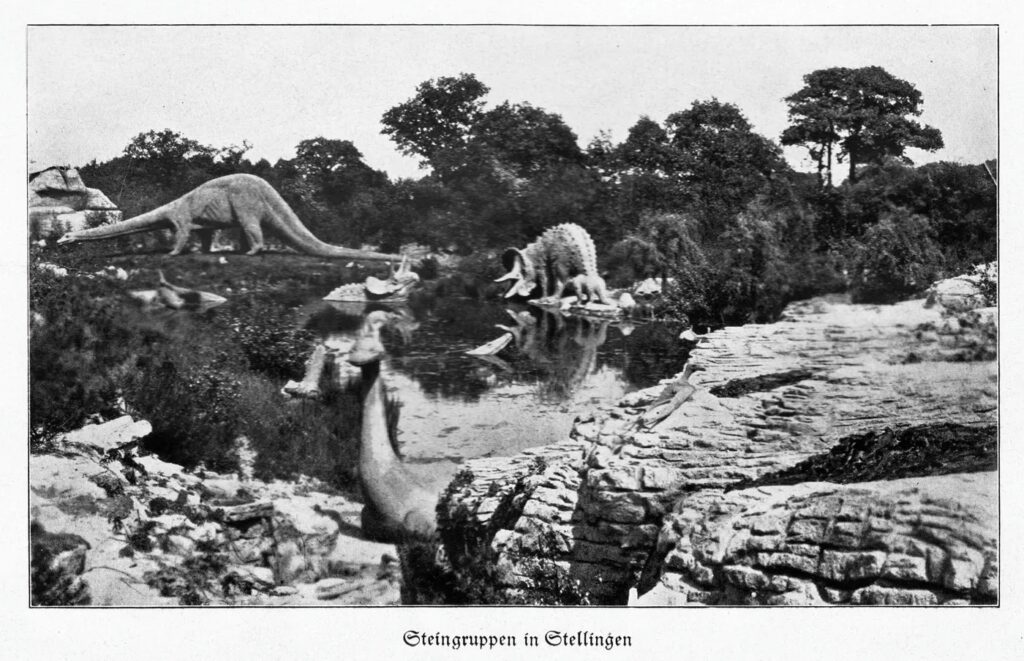
If Hagenbeck’s aim had been to promote his book and his new attractions Ñ and it probably was Ñ he had cause to congratulate himself. At home as well as abroad, both became in their own way best-sellers. But now that he hadlet the prehistoric cat out of the bag, others were willing to try their luck where they thought the famous German animal-trader to have failed.
One such person was a certain Charles Brooks from Johannesburg, who was widely reported in mid-1910 as a supporter of Hagenbeck’s claims about African dinosaurs. Even better, Brooks claimed to have seen these animals himself, but his descriptions were slightly more fanciful than Hagenbeck’s; he spoke of a giant elephant, a unicorn and a dragon Ñ the latter of which was supposed to represent Hagenbeck’s Diplodocus. Citing patriotic reasons,Brooks did not wish to leave these animals to the Germans, and intended to set up his own expedition to hunt them down. Articles in the papers carried his appeal to the British government to supply funding for the search.After this moment in the spotlight, however, nothing seems to have come of these plans.
Hubbard’s Painting
Although their activity would never gain quite the same notoriety, many have since continued the hunt,throughout the twentieth and twenty-first centuries. Their agendas became more varied over time, however. From adventurer’s tales and interesting but generally unverifiable accounts by colonial officials, stories about dinosaurs came into play as ammunition for a number of scientifically disestablishmentarianist groups. Such an episode where the continued existence of dinosaurs to the present day has been argued both by cryptozoologists and creationists, is Samuel Hubbard Jr’s “Dinosaur” painting.
In 1924, an expedition led by Grand Canyon explorer and writer Hubbard Jr. shot a number of photographs in the Havasupai Canyon in Arizona; most of his material contained alleged proof of the existence of human giants invery old geological strata. But to Hubbard, one painting provided evidence for the coexistence of dinosaurs and people. An outline of a creature in the rock seemed to bear resemblance to the painting Charles Knight prepared for the Scientific American issue dedicated to the unveiling of the Frankfurt in 1907. It was a very specific comparison: Knight had placed his upright, on its hind legs, a decidedly unorthodox decision that he nor anyone else repeated. It may not have been an entirely new idea, but it also wasn’t one that had been used widely. Knight’s painting was re-used and amended a number of times after that, for instance when used it to compare ‘ size to a human in 1922.
A number of (mainly religious) publications immediately reproduced Hubbard’s material and drew their conclusions, usually to the detriment of Darwin’s theory of evolution. Most of them did not fail to notice the “evasive” reaction by scientists such as the Smithsonian’s Charles Gilmore (who had participated in Hubbard’s journey) and Henry Fairfield Osborn; again these living dinosaurs were used as ammunition against the scientific establishment.
Diplodocus and Catholicism
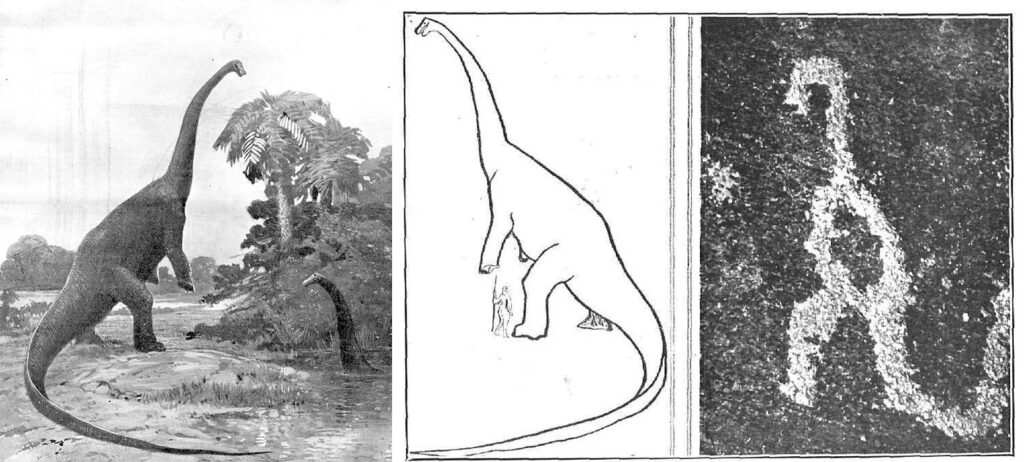
This attention wasn’t exclusively American, either. In 1925, for instance, a number of Spanish publications reported extensively about Hubbard’s find, and not wholly coincidentally used the Diplodocus to emphasize the points of human-dinosaurian coexistence and questionable dating methods that were being used in the service of evolution.
One of these was La Esfera (The Sphere), a staunchly orthodox Roman Catholic publication, which generally adopted an Ñ albeit ambiguous Ñ creationist stance. Diplodocus was familiar to the Spanish, since a Carnegiean copy was placed in Madrid in 1913. But despite the magazine’s agenda, even La Esfera’s writer is not entirely convinced of the Diplodocian identification of the cave painting, which could just as well be that of a mammal ofthis era or the next, or maybe simply a fantasy by the old inscriber of the rock. For ‘s author, that does not change the outcome: in both cases it proves the presence of incontrovertible evidence in favor of the cohabitation of extinct animals and man, and therefore against the theory evolution and established views of the age of the earth. Clearly, the anti-intellectualism of the American publications is just as prevalent here.
This post originally appeared as a chapter in my PhD thesis (2017) that did not make it to the book version, American Dinosaur Abroad.
